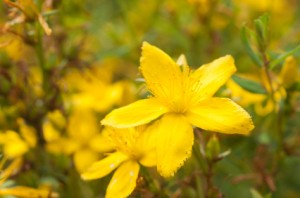Hypericum
 Hypericum (hy-PERRI-cum) is also known by the more common name of St John’s Wort and can be found in the UK (since 1594), where they have traditionally been cultivated for their medicinal properties, especially as an anti-depressant.
Hypericum (hy-PERRI-cum) is also known by the more common name of St John’s Wort and can be found in the UK (since 1594), where they have traditionally been cultivated for their medicinal properties, especially as an anti-depressant.
Description
St. John’s Wort can be found in variety of forms. Many are small herbaceous herbs while other species can be larger shrubs or even trees that can grow up to 12 metres in height. The simple oval leaves can be deciduous or evergreen and the flowers – generally consisting of five petals and similar to buttercups – can be anything from a pale to a dark yellow. The fruit tend to be fleshy and orange or red in colour and are rather similar to berries, although in some species they can be dry pods.
Habitat
Hypericum origins can be traced back to the Himalayas and China. Unfortunately, many of the species are considered as weeds that, while only a minor problem to farmlands and gardens, can be a major problem on pasture land.
Availability
Generally available all year round, hypericum has grown in popularity over recent years. While just a few years ago only one variety was widely available, there are now seven different varieties which have all been individually named.
Species
Hypericum is the name of the genus and there are over four hundred different species, including hypericum coris, hypericum balearicum and hypericum inodorum, which is also known as ‘Magical Passion’.
Care Tips
While the berries are highly regarded for their ornamental qualities, the leaves, unfortunately, are not so revered. In fact, in general they tend to fade very quickly and it is advisable to remove them as soon as any signs of fading occur.
Did you know?
Hypericum takes its name from the father of the sun, according to Greek mythology. He was named Hyperion, so the brightly coloured yellow flowers of Hypericum were in honour of him.
References
http://hypericum.com/toc.htm
http://www.nhm.ac.uk/natureplus/blogs/science-news/2011/01/13/480-species-of-plant-in-one-genus–hypericum?fromGateway=true


